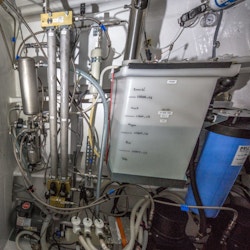The hydrogen chain step 2 : The Energy Observer electrolyser
Currently, 95% of the world’s hydrogen supply is from fossil fuel, through a reforming process using methane, the main component of natural gas. Electrolysis using a renewable energy source is a solution for the future use of green hydrogen on a large scale.
Electrolysis decomposes water molecules (H2O) into hydrogen (H2) and oxygen (O2) gas. More precisely, water is injected into the positive electrode (cathode) where it is first decomposed into oxygen, H+ ions and electrons. The H+ ions then migrate towards a negative electrode (anode) where they recombine with the electrons to form hydrogen. The membrane lets the protons migrate while blocking the electrons and making them circulate to the anode.
Electrolysers are usually bulky systems, so the CEA-Liten engineers had to design a more compact model for the Energy Observer. To do so, they converted a standard model from the company Proton Onsite, combining the structure with the fuel cell structure. The device can produce up to 4 Nm3 per hour of pure hydrogen, and consumes 3.66 litres of deionised water per hour.

The Energy Observer electrolyser
For the year 2018, the electrolyser operated for a total of 1,469 hours and produced a total of 488 kg of hydrogen, with 42% output. The engineers observed no degradation caused by the marine environment, nor premature wear. A small decrease in output was observed due to normal wear on the drying columns (-3%). They will be replaced this winter to ensure optimal output next year. T
his type of PEM electrolyser usually has a life cycle of several thousand hours, but given the harsh conditions in the humid and saline environment on the Energy Observer, the electrolyser will be observed closely.